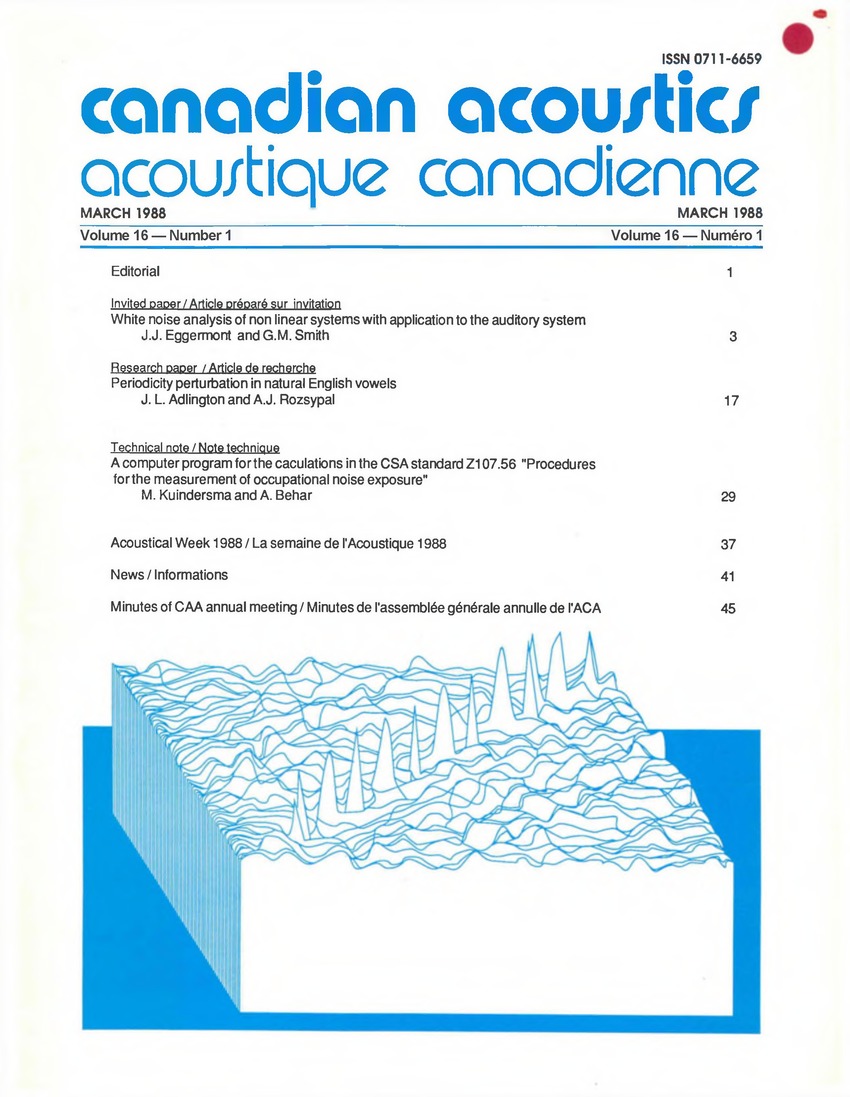White noise analysis of nonlinear systems with application to the auditory system
Mots-clés :
hearing, nonlinear systems, physiological models, auditory system, cross correlation, Gaussian wide band noise, uniform distributed random number generator, grassfrogRésumé
L'analyse des sytèmes linéaires au moyen de sons purs, de clics ou d'un bruit blanc donne essentiellement la même information: la réponse impulsionnelle ou la réponse en fréquence du système. Dans les systèmes non-linéaires tel que le système auditif, ces trois méthodes donnent des résultats différents. De plus, la réponse dépendra du niveau d'excitation. L'inter-corrélation d’ordre supérieur avec une bande de bruit gaussien comme signal d'entrée fournit, en principe, une méthode d'analyse des systèmes non-linéaires. A cette fin, on a besoin d'un bruit dont la fonction d'autocorrélation de second degré est nulle. Les générateurs de bruit pseudo-aléatoire disponibles sur le marché ne produisent pas un bruit qui rencontre ces exigences. Un bruit généré par programmation avec une distribution gaussienne d'amplitudes peut facilement être produit à partir d'un générateur de nombres uniformément distribués au hasard. En recourant à un bruit comportant de telles caractéristiques, nous avons étudié des neurones du cerveau moyen de la grenouille. Deux exemples sont présentées ainsi qu'une comparaison entre les résultats obtenus avec le bruit blanc et la méthode plus conventionnelle de l'analyse aux sons purs.Fichiers supplémentaires
Publié-e
Comment citer
Numéro
Rubrique
Licence
Author Licensing Addendum
This Licensing Addendum ("Addendum") is entered into between the undersigned Author(s) and Canadian Acoustics journal published by the Canadian Acoustical Association (hereinafter referred to as the "Publisher"). The Author(s) and the Publisher agree as follows:
-
Retained Rights: The Author(s) retain(s) the following rights:
- The right to reproduce, distribute, and publicly display the Work on the Author's personal website or the website of the Author's institution.
- The right to use the Work in the Author's teaching activities and presentations.
- The right to include the Work in a compilation for the Author's personal use, not for sale.
-
Grant of License: The Author(s) grant(s) to the Publisher a worldwide exclusive license to publish, reproduce, distribute, and display the Work in Canadian Acoustics and any other formats and media deemed appropriate by the Publisher.
-
Attribution: The Publisher agrees to include proper attribution to the Author(s) in all publications and reproductions of the Work.
-
No Conflict: This Addendum is intended to be in harmony with, and not in conflict with, the terms and conditions of the original agreement entered into between the Author(s) and the Publisher.
-
Copyright Clause: Copyright on articles is held by the Author(s). The corresponding Author has the right to grant on behalf of all Authors and does grant on behalf of all Authors, a worldwide exclusive license to the Publisher and its licensees in perpetuity, in all forms, formats, and media (whether known now or created in the future), including but not limited to the rights to publish, reproduce, distribute, display, store, translate, create adaptations, reprints, include within collections, and create summaries, extracts, and/or abstracts of the Contribution.


